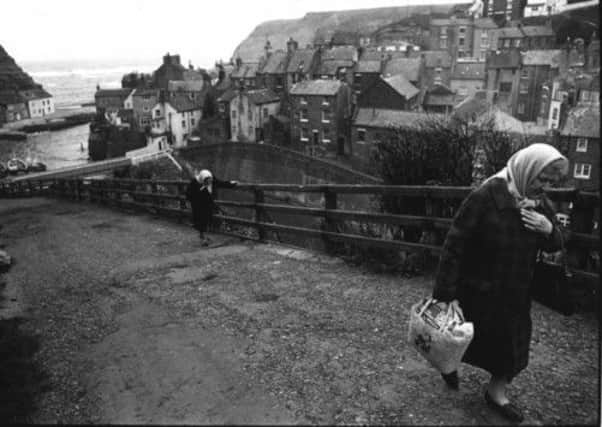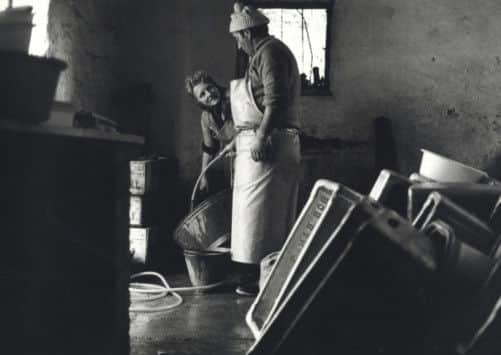Picturing the past


In 1970 Anthony Hutchinson from Scarborough was a graphic design student at a college in north London. That August he came back home, travelled a few miles further up the coast to Staithes and took lodgings.
His plan was to document in photographs a month in the life of the village and to produce a pictorial essay for his degree. That purpose was successfully achieved. Anthony later went on to enjoy a successful career and he is now retired and living in France.
Advertisement
Hide AdAdvertisement
Hide AdThe summer snapshot of Staithes life which he had captured so brilliantly lay forgotten and unseen. The photos have since been unearthed and now form the centrepiece of the Staithes Festival of Arts of Heritage later this month. Over the intervening 43 years Anthony’s pictures have acquired an added fascination, documenting the end of the era when fishing was everything here.


Teenage girls could still be found and photographed wearing the traditional bonnet of the fisherman’s wife, albeit rather self-consciously. Up quiet alleys, older women going about their daily household chores were framed in images that could be from the 1930s.
Today fishing remains, but only as part of the village’s picturesque appeal for heritage-seeking tourists. Anthony Hutchinson’s compelling pictures reveal that the day-to-day reality was as gritty as any urban heavy industry. He roamed around the village to reveal how making a living from the sea moulded lives.
There’s one terrific shot looking down at women in headscarves toiling up the precipitous main street with heavy bags of shopping. Their bent shoulders suggest they would have gladly swapped their reality for that of most 1970 housewives – especially the availability of a supermarket and a car to take them there.
Advertisement
Hide AdAdvertisement
Hide AdThere’s another picture of a couple engaged in the arduous and steamy business of boiling crabs. What makes this so outstanding is partly the play of light but mainly it’s the way the photographer has captured a fleeting look of affection between the man and woman as they toil. It’s as striking as an interior scene painted by a Dutch master.
The exhibition and the festival mark something of a change in fortune for Staithes. The village was on the way down once its principal economic activity had declined almost to vanishing point.
It has been the visual arts which have fashioned a signpost that points “up”. What altered the picture was an influx of middle-class professionals with the necessary assets of money and energy.
Their presence helped gentrify the village and their activities have made it vibrant again. This seems to have been accomplished without losing sight of what made the village unique or alienating locals whose families have been around for generations. In place of the fishing families like the Verrills, the Porrits, Longsters, Coles and Unthanks has come a different type of resident who probably doesn’t know much about the sea but has the skills needed for 21st-century survival and the leisure to apply them for civic benefit.
Advertisement
Hide AdAdvertisement
Hide AdOne of them, formerly a head of documentaries at YTV, has written a definitive history of the lifeboat and a version of the book will be launched on the festival weekend.
An example of a local life re-shaped by these social changes is a young joiner called Jason Micallef. He’s a Staithes tradesman renowned for his skills who spends his spare time restoring old fishing cobles. Buying oak for the ribs and larch for the planking just as the Vikings did when they invented the design, he then goes out fishing in them.
But Jason’s real job is refashioning the redundant Wesleyan chapel and overseeing its reinvention as the Sunday School Gallery. It will open with the Anthony Hutchinson festival exhibition.
The new gallery is the brainchild of one of the movers and shakers in the Staithes revival, Al Milnes. A former further education teacher living in York, Al opened an art gallery in an old Staithes shop in 2006. It prospered and has proved to be a catalyst for all sorts of innovatory activities, artistic and gustatory.
Advertisement
Hide AdAdvertisement
Hide AdIt’s a story and a place with such wide appeal that that the makers of BBC1’s Countryfile felt their six million viewers must be interested. They have been up to Staithes to film and their programme on the village goes out tomorrow.
A dozen or so “art colonies” sprang up in Britain in the latter part of the 19th-century and the seaside, made accessible by the new railways, were a popular place to be. The light was good for painting and it was cheap.
There was drama in the location and in the lives led here. It was a bit too dramatic for some. It’s said that one of the main reasons why Laura Knight, the chief adornment of the Staithes Group of artists, packed her bags was because she could not bear to see any more of the families she had got to know torn apart by disasters at sea.
A couple of full-time fishermen still live down in the village. The families the artists lived amongst have mostly gone. Sometimes only as far as the top of the cliff where you are able to do things that people in more humdrum places take for granted, such as being able to park your car, catch a bus and visit a post office. Today the village’s 100 permanent residents are outnumbered by 150 part timers.
Advertisement
Hide AdAdvertisement
Hide Ad“The recession hit us and vacant old buildings can soon look shabby again,” says Al.
“They can quickly deteriorate in the sea air unless they are loved. But I think we’ve possibly turned a corner.”
A few yards away from her galley on one side stands The Endeavour, a fish restaurant opened by an ex-Yorkshire Post reporter which despite establishing a national reputation over many years, eventually went under. But it has recently resurfaced with new owners. On Al’s other side is a café bistro where a similar sequence of events has resulted in everyone smiling once more.
Dame Laura Knight died in 1970 but her popularity is undimmed – the National Portrait gallery is currently mounting an exhibition of her work. The legacies of the art colonies in other places such as St Ives and Newlyn in Cornwall however were more permanent.
Advertisement
Hide AdAdvertisement
Hide AdThis is what struck Al when she started coming here with her husband Dave, a psychiatrist. “We thought it was shame there was nothing here that celebrated the history and the heritage of the art that was going on here. I suppose we thought that if it had been Cornwall it would have been full of galleries.
“Our Staithes Gallery created a community where people meet up and talk. It’s possible it wouldn’t have happened but for the gallery.”
The Wesleyan chapel had been on the market for a couple of years before they took the plunge to give another landmark building in the village a new lease of life.
“The chapel was down to half a dozen worshippers by the end,” says Al.
Advertisement
Hide AdAdvertisement
Hide Ad“But going to chapel and to Sunday school was a thing that families used to do and a lot of people were attached to it emotionally. We thought that if we didn’t take it on what would happen to the building otherwise?”
So this splendid building, once so vital to people for whom providence and God’s grace loomed large, is now set to be the focus of the community once again. Anticipation from the locals about what familiar or forgotten faces they may find among Anthony Hutchinson’s 1970 photographs is intense.
“The festival has brought the two communities together,” adds Al. “We have made it about heritage as well as art.”
More than 100 artists will be exhibiting in 78 venues and scores of cottages and public buildings will throw open their doors to the public as pop-up galleries.
Advertisement
Hide AdAdvertisement
Hide AdYou can learn how to make a lobster pot, join guided walks, discover quiet corners and secret streets, and at 9 o’clock on Saturday night watch vintage images of the village projected onto the wall at Kipper’s Corner.
The pop-up tea rooms that are promised have the most intriguing locations. One will be in a cottage in Gun Gutter and another will be at Singing Waters on the High Street.
The Countryfile programme will no doubt help attendances. In fact television has done the village proud recently. Parents, or grandparents with youngsters to entertain, will recognise Staithes as the setting for the current CBeebies series Old Jack’s Boat with Bernard Cribbins.
It’s a good job that there’s so much enterprise around from the private sector to make Staithes a destination of choice. There doesn’t appear to be much of it from the local council.
Advertisement
Hide AdAdvertisement
Hide AdAt the height of the season in mid-August, a visitor would discover that the tourist information office and the public toilets on the car park at the top of the cliff close at 4pm.
Helping to make holidaymakers stay informed and comfortable and giving Staithes a welcoming face does not seem to be on the council’s agenda.
Staithes 1970 – The Lost Archive opens as part of the Staithes Festival of Arts and Heritage, September 14 & 15. www.staithesfestival.com